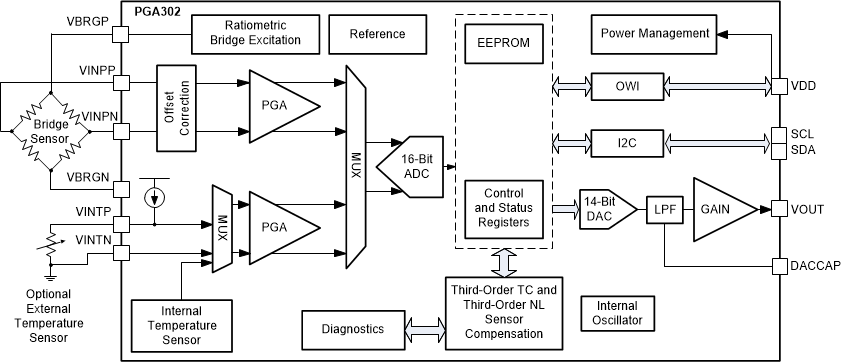SBASB65 August 2024 PGA302
PRODUCTION DATA
3 Description
The PGA302 is a low-drift, low-noise, programmable signal-conditioner device designed for a variety of resistive bridge-sensing applications like pressure-, temperature-, and level-sensing applications. The PGA302 can also support flow metering applications, weight scale and force-sensing applications that use strain gauge load cells, and other general resistive bridge signal-conditioning applications.
The PGA302 provides a bridge excitation voltage of 2.5V and a current output source with programmable current output up to 1mA. At the input, the device contains two identical analog front-end (AFE) channels followed by a 16-bit Sigma-Delta ADC. Each AFE channel has a dedicated programmable gain amplifier with gain up to 200V/V.
In addition, one of the channels integrates a sensor offset compensation function while the other channel integrates an internal temperature sensor.
At the output of the device, a 1.25V, 14-bit DAC is followed by a ratiometric-voltage supply output buffer with gain of 4V/V allowing a 0V-5V ratiometric voltage system output. The PGA302 device implements a third-order temperature coefficient (TC) and non-linearity (NL) digital compensation algorithm to calibrate the analog output signal. All required parameters for the linearization algorithm as well as other user data is stored in the integrated EEPROM memory.
 PGA302 Simplified Block Diagram
PGA302 Simplified Block DiagramFor system connectivity the PGA302 device integrates an I2C Interface as well as a one-wire interface (OWI) that supports communication and configuration through the power-supply line during final system calibration process. Diagnostics are implemented at the excitation output sources, the input to the AFE and the power supplies in the device. System Diagnostics like sensor open / short are also supported.
The PGA302 accommodates various sensing element types, such as piezoresistive, ceramic film, strain gauge, and steel membrane. The device can also be used in accelerometer, humidity sensor signal-conditioning applications, as well as in some current-sensing, shunt-based applications.